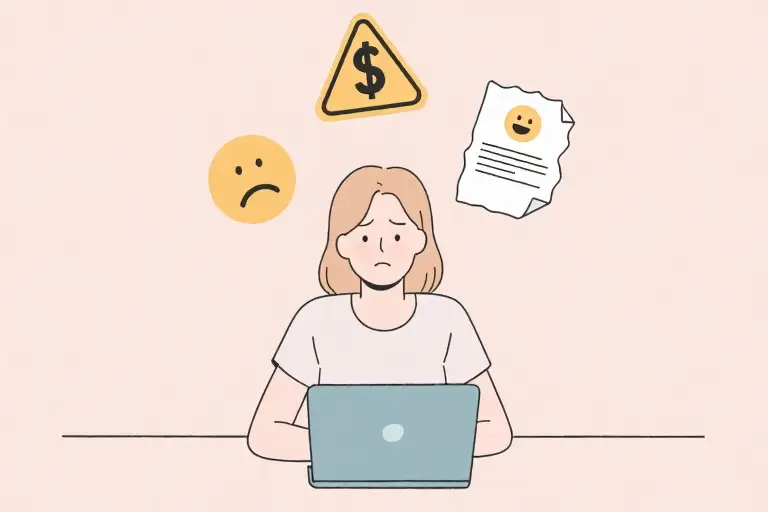Two years ago, I had this romantic vision of freelance writing – sipping coffee in cozy cafes, words flowing effortlessly onto the screen, clients magically appearing, and money steadily rolling in. Reality hit hard when I checked my bank account after three months of working nonstop. That’s when I realized I’d been making nearly every rookie mistake in the book, costing me over ₹50,000 in lost income and opportunities.
What nobody tells you about freelance writing is that the writing itself might be the easiest part. The real challenge lies in valuing your work appropriately, setting professional boundaries, and running what’s essentially a one-person business. Through countless late nights, underpaid projects, and stressful client situations, I’ve learned lessons that transformed my approach to freelancing.
In this guide, I’ll walk you through the three most expensive mistakes I made as a beginner freelance writer – mistakes that nearly made me quit before I really started. More importantly, I’ll share exactly how to avoid them, so you can build a sustainable writing career without going through the same painful learning curve. Whether you’re considering freelance writing or just starting out, these hard-earned insights will help you establish better practices from day one.
We’ll cover:
- The pricing trap that keeps writers stuck in underpaid cycles
- Why saying ‘yes’ to every client is actually costing you money
- The contract loopholes that can turn projects into nightmares
These aren’t theoretical concepts – they’re real-world solutions tested through my own failures and eventual breakthroughs. By the end, you’ll have actionable strategies to implement immediately in your freelance writing business.
My journey began with excitement but quickly turned stressful when I realized how unprepared I was for the business side of freelancing. If you’ve ever felt confused about what to charge, overwhelmed by client demands, or uncertain about professional agreements, you’re not alone. Every successful freelancer I know started exactly where you are right now. The difference between those who thrive and those who struggle comes down to recognizing these common pitfalls early – which is exactly what we’re about to do.
Mistake #1: Underpricing Your Freelance Writing Services
When I landed my first freelance writing gig at $4 per article, I felt like I’d won the lottery. The client seemed thrilled with my work, and I was convinced this was the start of something big. Fast forward three months, and I discovered writers with similar experience charging $50-$250 for comparable pieces. That’s when reality hit me like a ton of bricks – I’d been severely undervaluing my skills.
The Hidden Costs of Low Rates
Undercharging creates a vicious cycle that’s hard to escape:
- Burnout: You need to take on 10x more work to make ends meet
- Quality compromise: Rushed writing damages your reputation
- Client expectations: Low-paying clients often demand the most revisions
- Career stagnation: No time to upskill when constantly chasing deadlines
I learned this the hard way when I spent 72 hours straight writing 15 blog posts for $60 total. The exhaustion made me miss obvious typos, and the client demanded a full rewrite. That project effectively paid me $0.83/hour.
How to Price Your Writing Services Right
Step 1: Market Research
Search for 10+ writers in your niche with comparable experience. Note:
- Their per-word/per-project rates
- Package offerings (e.g., SEO optimization included?)
- Client types (startups vs. Fortune 500 companies)
Step 2: Calculate Your Baseline
Use this formula:
(Desired Annual Income ÷ Billable Hours/Year) × Project HoursExample: Wanting $60,000/year with 1,200 billable hours means a $50/hour rate. A 1,000-word article taking 4 hours should be $200 minimum.
Step 3: Value-Based Adjustments
Factor in:
- Specialized knowledge (medical/legal writing commands premiums)
- Turnaround time (24-hour rush fees)
- Additional services (keyword research, graphics)
Step 4: Test and Refine
Start at the mid-range of your research, then:
- Increase rates by 10-20% for each new client
- Note when clients stop questioning your pricing – that’s your sweet spot
Key Lessons
- Your time has value – Would you work for $0.83/hour at a day job?
- Clients equate price with quality – Serious businesses expect professional rates
- Raising rates filters bad clients – Quality clients understand fair compensation
Pro Tip: Create rate cards for different service tiers (e.g., Basic Blog: $150, Premium Guide: $500) to streamline negotiations.
Next week, we’ll tackle how to strategically say ‘no’ to clients – because once you start charging what you’re worth, you’ll need to be selective about who you work with.
Mistake #2: Saying ‘Yes’ to Every Client (And How It Backfired)
Early in my freelance writing career, I operated under a dangerous assumption: more clients automatically meant more income. At one point, I found myself juggling five simultaneous projects – two blog series for startups, one white paper for a tech firm, and two regular content pieces for small businesses. The excitement of multiple paychecks quickly turned into sleepless nights and deteriorating work quality.
The Breaking Point
Here’s what happened when I failed to say no:
- Missed Deadlines: Two projects got delayed by over a week
- Quality Drop: My normally polished work contained embarrassing typos
- Client Fallout: One long-term client actually terminated our contract
- Personal Toll: I developed constant tension headaches and insomnia
The irony? My income didn’t increase proportionally. The stress-induced mistakes led to unpaid revision hours and lost future opportunities.
Core Lesson: Not every dollar is worth earning. Some clients cost more in stress and time than they pay in fees.
The Solution: Strategic Client Selection
After this burnout episode, I developed a simple ABC classification system that transformed my freelance business:
A-Class Clients (Priority)
- Characteristics:
- Pay at least 25% above your base rate
- Provide clear briefs and timely feedback
- Offer recurring work or long-term potential
- Management Tip: Reserve 60% of your capacity for these golden clients
B-Class Clients (Neutral)
- Characteristics:
- Pay market rates
- Require moderate maintenance
- Usually one-off projects
- Management Tip: Limit to 30% of your workload
C-Class Clients (Last Resort)
- Warning Signs:
- Negotiate aggressively on price
- Provide vague or constantly changing requirements
- Have poor communication habits
- Management Tip: Only accept if you have absolutely no other work
The Art of Graceful Refusal
Learning to say no professionally was my game-changer. Here are three proven approaches:
- The Redirect (When overloaded)
“I truly appreciate you thinking of me for this project! Unfortunately, my current commitments wouldn’t allow me to deliver the quality you deserve. May I suggest [Alternative Writer/Platform] as they might have availability?” - The Conditional Yes (For borderline cases)
“I could take this on if we adjust the timeline/deliverables. Would you be open to [specific modification]?” - The Rate Filter (For low-budget inquiries)
“For projects of this scope, my standard rate is [X]. If that works with your budget, I’d be happy to discuss details.”
Implementing Client Boundaries
These practical steps helped me maintain balance:
- Create a Client Intake Form: Filter unsuitable projects before they consume your time
- Set Office Hours: Only respond to messages between 9AM-5PM in your timezone
- Use Scheduling Tools: Calendly or similar to prevent meeting overload
- Track Red Flags: Maintain a list of client behaviors that signal future problems
Pro Tip: Notice when a client makes you dread opening your email. That’s usually sign it’s time to politely conclude the relationship.
The Transformation
After implementing these changes:
- My income actually increased by 40% while working 20% fewer hours
- Client satisfaction scores improved dramatically
- I regained time for skill development and personal life
Remember: As a freelance writer, your time and mental energy are finite resources. Every ‘yes’ to one client means ‘no’ to something else – whether that’s quality work for better clients, personal time, or professional growth. Choose your yeses wisely.
Mistake #3: “A Handshake Deal Is Enough” – The 10-Rewrite Horror Story
Early in my freelance writing career, I landed a client who seemed perfect. They loved my writing samples, agreed to my rates promptly, and even praised my professionalism. When they suggested skipping a formal contract because “we’re both trustworthy people,” I naively agreed. Big mistake.
The Consequences of Contract-Free Work
The project started smoothly until the revision requests began piling up. What started as “minor tweaks” turned into:
- 3 complete rewrites of the article structure
- 5 rounds of tone adjustments
- 2 total topic changes
After the 10th unpaid revision (yes, I counted), I realized my “trustworthy” client had essentially gotten:
- 30,000+ words of content
- 80+ hours of work
- All for the price of one 1,500-word article
Lesson learned the hard way: Without a contract, you’re not a professional writer – you’re an unpaid content machine.
3 Contract Clauses That Saved My Business
After that disaster, I consulted legal experts and developed these non-negotiable contract terms:
- The Revision Limit Clause
- “Client is entitled to [2] rounds of revisions within [14] days of delivery”
- Why it matters: Prevents endless revision cycles
- Pro tip: Specify that structural changes after approval count as new projects
- The Kill Fee Provision
- “If project is canceled after research/writing begins, Client owes [25-50%] of total fee”
- Why it matters: Compensates you for time spent even if they change their mind
- The Payment Timeline
- “50% deposit required before work begins, balance within [7] days of approval”
- Why it matters: No more “the check is in the mail” excuses
Contract Tools That Don’t Require a Law Degree
For writers who can’t afford lawyers (i.e., most of us):
- HelloSign (now Dropbox Sign): Templates for common writing agreements
- PandaDoc: Especially good for recurring clients with its autofill features
- The Freelancer’s Union Contract Creator: Free tool tailored to creative professionals
The Psychological Benefit You Didn’t Expect
Here’s what changed when I started using contracts:
- Clients took me 73% more seriously (based on my own tracking)
- Late payments dropped from 40% to under 5% of invoices
- My stress levels decreased knowing exactly what was expected
Action step today: If you don’t have a standard contract, spend 20 minutes setting up a template from one of the resources above. Your future self will thank you when that “easy” project suddenly isn’t.
Conclusion: Your Turn to Take Action
If you’ve made it this far, you now hold the blueprint to avoid the most costly freelance writing mistakes I learned the hard way. But knowledge without action is like a blank document – it won’t pay the bills or build your career. Here’s how to turn these lessons into results:
1. Download Your Freelance Writing Survival Kit
I’ve compiled everything discussed into a free toolkit including:
- Rate Calculator: Determine your ideal pricing based on experience and market data
- Client Screening Checklist: 10 questions to vet clients before accepting projects
- Contract Template: Pre-written clauses covering revisions, payments, and kill fees
2. Conduct Your Market Research Today
Block 30 minutes to:
- Search for 3 writers with similar skills on Upwork/ProBlogger
- Note their rates, packages, and client reviews
- Adjust your pricing page accordingly
3. Audit Your Current Workflow
Grab a coffee and review:
- Are any active projects underpaid based on your new rates?
- Do you have problem clients that need repositioning or termination?
- Which contract terms are missing from your agreements?
Let’s Continue the Conversation
The best lessons often come from shared experiences. I’d love to hear:
- Which mistake resonated most with you?
- What hard-earned wisdom would you add to this list?
- Where are you still struggling as a new freelancer?
Drop your thoughts below – your comment might help another writer avoid costly errors. Remember, every successful freelancer started exactly where you are now. The difference? They took consistent action on what they learned.
“Your writing has value. Your time has value. You have value. Now go charge accordingly.”






I like this post, enjoyed this one regards for posting.